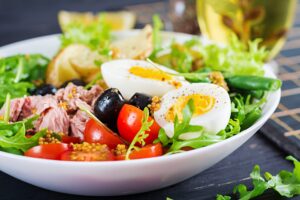Are you struggling to lose weight and achieve your fitness goals? Well, here’s an interesting statistic for you: did you know that incorporating whole foods into your diet can significantly help you in your weight loss journey? Yes, it’s true!
Whole foods are not only delicious and nutritious, but they also have numerous benefits that can support your weight loss goals.
Now, you might be wondering, what exactly are whole foods? Whole foods are unprocessed and unrefined foods that are as close to their natural state as possible. Think fruits, vegetables, whole grains, lean proteins, and healthy fats. These foods are packed with essential nutrients, fiber, and antioxidants that can nourish your body and help you shed those extra pounds.
By incorporating whole foods into your diet, you can not only fuel your body with the right nutrients but also promote overall health and well-being.
In this article, we will delve deeper into the benefits of whole foods and how you can incorporate them into your diet effectively. We will explore the importance of building a balanced meal plan with whole foods, boosting your metabolism, and tracking your progress.
So, if you’re ready to take control of your weight loss journey and serve yourself the best possible way, let’s dive into the world of whole foods and discover how they can help you achieve your weight loss goals.
Key Takeaways
- Whole foods are unprocessed and unrefined, packed with essential nutrients, fiber, and antioxidants.
- Whole foods have a lower calorie density compared to processed foods.
- Incorporating whole foods into the diet can boost metabolism, decrease inflammation, and promote healthy digestion.
- Building a balanced meal plan with whole foods ensures the intake of essential vitamins, minerals, and macronutrients.
Understanding the Benefits of Whole Foods
You’ll be amazed at how incorporating whole foods into your diet can effortlessly support your weight loss goals. Whole foods are unprocessed and unrefined, making them rich in essential nutrients that your body needs to function at its best. These foods are packed with vitamins, minerals, and antioxidants that can help boost your metabolism, decrease inflammation, and promote healthy digestion.
By choosing whole foods over processed foods, you nourish your body with the best possible fuel, giving it the tools it needs to shed excess weight. Not only are whole foods nutritious, but they also tend to be lower in calorie density compared to processed foods. This means that you can eat larger volumes of whole foods for the same amount of calories as smaller portions of processed foods.
For example, a plate of colorful vegetables and lean protein will leave you feeling satisfied, while providing your body with the necessary nutrients, all for fewer calories than a fast food meal. By incorporating more whole foods into your diet, you can eat more food, feel fuller, and still create a calorie deficit that supports weight loss. It’s a win-win situation!
Incorporating Whole Foods into Your Diet
By incorporating nutrient-rich, unprocessed ingredients into your meals, your journey toward weight loss becomes more enjoyable and sustainable.
Whole foods, such as fruits, vegetables, lean proteins, and whole grains, provide essential nutrients supporting your overall health and well-being. These foods are packed with vitamins, minerals, fiber, and antioxidants that not only help you lose weight but also boost your immune system, improve digestion, and promote a healthy heart.
When it comes to incorporating whole foods into your diet, it’s all about making small, manageable changes that you can stick to in the long run. Start by replacing processed snacks with fresh fruits or raw nuts. Swap refined grains like white bread and pasta with whole grain alternatives like quinoa and brown rice. Instead of reaching for sugary drinks, opt for water or herbal tea.
By gradually incorporating these whole foods into your meals, you’ll not only be nourishing your body but also satisfying your taste buds.
So, embrace the power of whole foods and enjoy the journey towards a healthier, happier you.
Building a Balanced Meal Plan with Whole Foods
When incorporating whole foods into your meal plan, it’s important to focus on creating a balanced and nourishing combination of nutrients.
By building a well-rounded meal plan with whole foods, you can ensure that you are getting all the essential vitamins, minerals, and macronutrients your body needs to thrive.
Start by including a variety of fruits and vegetables in your meals. These colorful and nutrient-rich foods provide a wide range of vitamins, antioxidants, and fiber that support your overall health and weight loss goals.
Next, be sure to include lean proteins in your meals. Options like chicken breast, fish, tofu, and beans are not only packed with protein, but they also provide important amino acids that are essential for muscle growth and repair. Protein also helps to keep you feeling full and satisfied, which can prevent overeating and help with weight loss.
In addition to fruits, vegetables, and proteins, don’t forget to include whole grains in your meal plan. Foods like quinoa, brown rice, and whole wheat bread provide complex carbohydrates that give you energy and help to keep you feeling full. They also contain fiber, which aids in digestion and can contribute to weight loss by promoting feelings of satiety.
By focusing on building a balanced meal plan with whole foods, you are not only nourishing your body but also setting yourself up for success in achieving your weight loss goals.
With a little bit of planning and creativity, you can create delicious and satisfying meals that support your weight loss journey.
Boosting Your Metabolism with Whole Foods
Boost your metabolism by incorporating whole foods into your diet. Whole foods are packed with essential nutrients that can help rev up your body’s calorie-burning engine and keep it running smoothly. These foods are minimally processed and free from additives, making them a healthier choice for weight loss.
One great way to boost your metabolism with whole foods is by including plenty of lean proteins in your meals. Foods like chicken, fish, and tofu are not only rich in protein, but they also require more energy to digest, which means your body burns more calories in the process. Additionally, protein helps build and maintain muscle mass, which can further increase your metabolic rate.
Another way to give your metabolism a boost is by incorporating spicy foods into your diet. Spices like cayenne pepper, ginger, and turmeric can temporarily increase your metabolic rate and help you burn more calories. Plus, they add flavor to your meals without adding extra calories, making them a delicious and healthy addition to your weight loss plan.
By choosing whole foods that are nutrient-dense and promote a higher metabolic rate, you can support your weight loss goals and achieve the results you desire.
So go ahead and enjoy a variety of whole foods in your diet, and watch as your metabolism works harder to help you shed those unwanted pounds.
Nourishing Your Body with Fresh Fruits and Vegetables
Start by savoring the vibrant flavors and nourishing benefits of fresh fruits and vegetables. These colorful gems of nature are not only delicious, but they also provide your body with essential vitamins, minerals, and antioxidants that can support your weight loss journey.
Whether it’s a juicy apple, a crisp cucumber, or a sweet strawberry, each bite is a gift to your body. As you indulge in these nature treats, you’re not only nourishing yourself but also setting an example for those around you. Your loved ones will be inspired by your commitment to health and may be encouraged to incorporate more fruits and vegetables into their diets.
In addition to their nutritional value, fresh fruits and vegetables can also help you achieve your weight loss goals. These low-calorie, high-fiber foods can keep you feeling fuller for longer, reducing the temptation to snack on unhealthy options. They’re also packed with water, which helps hydrate your body and satisfy your thirst.
As you make these healthy choices, don’t forget that you’re not just nourishing your own body but also creating a ripple effect of positive change. By prioritizing the well-being of your own body, you’re indirectly serving others and inspiring them to take better care of themselves.
So, embrace the vibrant colors and flavors of fresh fruits and vegetables, and let them fuel your weight loss journey.
Choosing Lean Proteins for Weight Loss
Opting for lean proteins can be a delicious and satisfying way to support your weight loss goals. By choosing lean proteins, you’re not only nourishing your body but also helping it burn fat more efficiently.
Here are five reasons why incorporating lean proteins into your diet can be a game-changer for your weight loss journey:
- Lean proteins are low in calories and high in nutrients, making them an excellent choice for weight loss. They provide your body with essential amino acids, vitamins, and minerals without adding unnecessary calories.
- Protein-rich foods help you feel full and satisfied for longer periods, reducing the chances of overeating or snacking on unhealthy foods. They can help curb cravings and keep your hunger at bay, making it easier to stick to your weight loss plan.
- Lean proteins promote muscle growth and repair, which is crucial for weight loss. Building and maintaining lean muscle mass can boost your metabolism and increase the number of calories your body burns at rest.
- Including lean proteins in your meals can help stabilize your blood sugar levels and prevent spikes and crashes in energy. This can lead to improved energy levels and a better overall mood throughout the day.
- Opting for lean proteins can add variety and flavor to your meals. From grilled chicken and fish to tofu and legumes, there are endless options to explore and experiment with. This can keep your meals interesting and enjoyable, making it easier to stick to your weight loss plan in the long run.
Incorporating lean proteins into your diet is a simple and effective way to support your weight loss goals. Not only will you be providing your body with essential nutrients, but you’ll also be satisfying your taste buds and keeping your hunger in check.
So go ahead, explore the world of lean proteins, and discover new delicious ways to nourish your body and achieve your weight loss goals.
Tracking Your Progress and Adjusting Your Whole Foods Diet
Start tracking your progress and adjusting your whole foods diet to see real results on your weight loss journey. Keeping track of what you eat and how it affects your body is an essential step in achieving your weight loss goals.
By monitoring your food intake, you can identify any patterns or habits hindering your progress. This can help you make necessary adjustments to your whole foods diet and ensure that you are on the right track toward success.
One effective way to track your progress is by keeping a food journal. Write down everything you eat and drink throughout the day, including portion sizes and any additional notes about how you feel after each meal. This will help you become more aware of your eating habits and can highlight any areas where you may need to make changes.
For example, you may notice that you tend to overeat when you’re feeling stressed or that certain foods make you feel bloated or sluggish. Armed with this knowledge, you can then make adjustments to your diet, such as reducing portion sizes or avoiding certain trigger foods.
In addition to keeping a food journal, it’s also important to regularly assess your progress and adjust your whole foods diet as needed. This means paying attention to how your body feels and responds to the changes you’re making. If you’re not seeing the results you desire, it may be necessary to make further adjustments to your diet.
This could involve experimenting with different whole foods or tweaking portion sizes to find what works best for your body. Don’t forget, everyone’s weight loss journey is unique, so what works for one person may not necessarily work for another. Stay committed to serving yourself by continuously evaluating your progress and making the necessary adjustments to your whole foods diet.
Frequently Asked Questions
Can whole foods help with weight loss even if I have dietary restrictions or specific food allergies?
Yes, whole foods can still help you reach your weight loss goals even if you have dietary restrictions or food allergies. With a wide variety of options available, you can find nutritious and satisfying alternatives that fit your needs.
How can I incorporate whole foods into my diet if I have a busy schedule and limited time for meal preparation?
If you have a busy schedule and limited time for meal prep, don’t worry! Incorporating whole foods into your diet is still possible. Simplify your meals by choosing quick and easy options like fruits, vegetables, lean proteins, and whole grains.
Are there any specific whole foods that are known to be more effective for boosting metabolism and aiding in weight loss?
To boost your metabolism and aid in weight loss, focus on whole foods like lean proteins (chicken, fish), fruits (berries, grapefruit), vegetables (spinach, broccoli), and whole grains (quinoa, oats). These nutrient-dense choices will support your goals.
Can I still enjoy occasional treats and indulgences while following a whole-food diet?
Yes, you can still enjoy occasional treats and indulgences while following a whole-food diet. It’s all about balance and moderation. Remember, life is too short to completely deprive yourself of the simple pleasures!
What strategies can I use to stay motivated and on track with my weight loss goals while following a whole foods diet?
To stay motivated and on track with your weight loss goals while following a whole foods diet, focus on small, achievable steps. Set specific goals, find accountability partners, and reward yourself for milestones. Prioritize self-care and celebrate your progress along the way.














